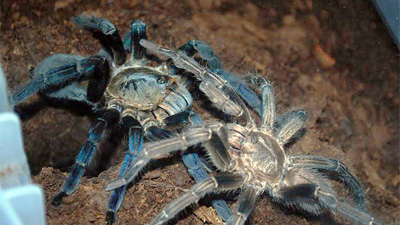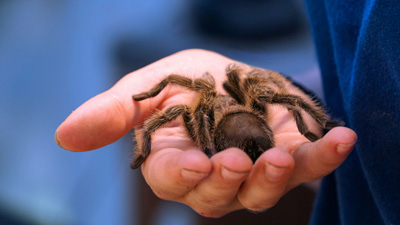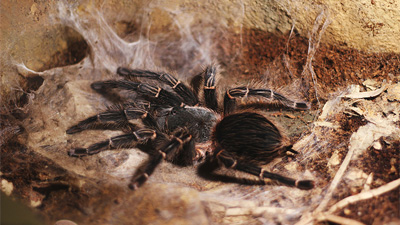What Happens if a Cobalt Blue Tarantula Bites You?

Photo by Rushenb on Wikimedia
Cobalt blue tarantulas, with their striking azure coloration and formidable appearance, are among the most captivating species of tarantulas found in the exotic pet trade. While these arachnids are known for their reclusive nature and generally docile demeanor, the prospect of a bite from a cobalt blue tarantula can evoke concern among enthusiasts and novices alike.
In this article, we delve into the consequences of a cobalt blue tarantula bite and explore the potential effects on human health.
Anatomy and Behavior of the Cobalt Blue Tarantula
Before examining the effects of a cobalt blue tarantula bite, it's essential to understand the anatomy and behavior of these fascinating creatures. Scientifically known as Haplopelma lividum, cobalt blue tarantulas are native to Southeast Asia, where they inhabit burrows in the forest floor.
Cobalt blue tarantulas are characterized by their striking blue coloration, which extends from their cephalothorax to their abdomen and legs. They possess robust fangs used to subdue their prey, primarily consisting of insects and other small invertebrates.
In their natural habitat, cobalt blue tarantulas are primarily nocturnal hunters, emerging from their burrows under the cover of darkness to search for food. They are generally shy and reclusive, preferring to retreat into their burrows when threatened rather than confront potential predators.
Bite Effects on Humans
Like other tarantula species, the Cobalt Blue Tarantula possesses venom. While each tarantula's venom composition varies, the Cobalt Blue Tarantula's venom is known to contain neurotoxins that primarily affect the nervous system. These neurotoxins can cause various symptoms and reactions in humans, ranging from local effects to systemic complications.
Cobalt Blue Tarantula bites are generally considered more severe compared to other tarantula species, primarily due to the potency of their venom. However, it is essential to note that bites from this species are still relatively rare, as it tends to be less aggressive than other tarantulas.
Upon a bite, initial symptoms typically include localized pain, redness, and swelling around the bite site. The immediate discomfort can range from mild to intense, depending on individual sensitivity. It is important to avoid scratching or exacerbating the area to prevent potential infection.
Potential Complications and Allergic Reactions
While most individuals experience localized symptoms only, some may exhibit more severe or systemic reactions. These complications may include:
Localized reactions: In some cases, the bite area may develop necrotic lesions or skin ulcers. These ulcers can take time to heal and may require medical attention, including wound care and possible administration of antibiotics.
Systemic symptoms: Although rare, an allergic or hypersensitive reaction can occur in response to a Cobalt Blue Tarantula bite. This can result in symptoms such as difficulty breathing, chest tightness, dizziness, swelling of the face or throat, and a rapid heartbeat. If any of these symptoms are experienced, immediate medical attention is necessary.
Treatment and Management
If bitten by a cobalt blue tarantula, it's essential to take prompt action to minimize the risk of complications and promote healing. The following steps can help manage a tarantula bite:
Wash the bite site with soap and water to reduce the risk of infection.
Apply a cold compress or ice pack wrapped in a cloth to alleviate pain and swelling.
Elevate the affected limb if possible to reduce swelling.
Monitor for signs of allergic reactions or infection, seeking medical attention if necessary.
Avoid scratching or irritating the bite site, as this can increase the risk of infection.
If experiencing severe symptoms or allergic reactions, seek immediate medical attention.
Preventing Tarantula Bites
While tarantula bites are relatively rare, there are precautions individuals can take to reduce the risk of being bitten:
Avoid handling or provoking cobalt blue tarantulas unnecessarily.
Wear protective clothing, such as gloves, when working with tarantulas or cleaning their enclosures.
Educate yourself about tarantula behavior and warning signs of aggression.
Keep pet tarantulas in secure enclosures to prevent accidental escapes or encounters.
Seek professional assistance if dealing with a tarantula infestation in your home or property.
Conclusion
While the Cobalt Blue Tarantula bite can result in more severe symptoms compared to other tarantulas, it is important to remember that bites from this species are relatively rare. The vast majority of individuals experience localized effects, such as pain, redness, and swelling, which can be managed with proper wound care. It is crucial to observe any progression of symptoms and seek medical attention if there are signs of a severe reaction or complications.
By following the recommended actions, such as staying calm, cleaning the wound, and seeking medical advice when necessary, one can minimize discomfort and maximize the potential for a safe and expedient recovery.
While the Cobalt Blue Tarantula is a fascinating and beautifully colored species, it is important to exercise caution and respect when interacting with it. Adhering to proper handling techniques and maintaining a safe environment for both humans and tarantulas can help prevent bites and ensure a harmonious coexistence.
You May Also Like
 Other Pets50 Popular Names for Tarantulas (with Meaing)
Other Pets50 Popular Names for Tarantulas (with Meaing) Other PetsThe Price of Cobalt Blue Tarantula in the US ($50 to $200)
Other PetsThe Price of Cobalt Blue Tarantula in the US ($50 to $200) Other Pets6 Best Tarantula Species for Beginners
Other Pets6 Best Tarantula Species for Beginners Other Pets10 FAQs About Cobalt Blue Tarantulas
Other Pets10 FAQs About Cobalt Blue Tarantulas Other PetsWhat Happens if a Pink Toe Tarantula Bites You?
Other PetsWhat Happens if a Pink Toe Tarantula Bites You? Other PetsWhat Happens if a Rose Hair Tarantula Bites You?
Other PetsWhat Happens if a Rose Hair Tarantula Bites You?